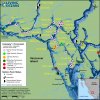Celebrity activists launch B.C. salmon farm expedition
David Suzuki gets pretty scatological when he talks about his problems with open-net salmon farming on B.C.’s coast.
“As a scientist, it makes no sense to grow animals in open nets where you use the ocean as a shithouse,” the famed environmentalist told reporters Monday. “Not only are you pooping in the ocean, but you’re also sharing the growth of sea lice and infections that explode in the enclosures.”
Suzuki has joined forces with actor
Pamela Anderson, biologist Alexandra Morton and First Nations leaders to launch Operation Virus Hunter, a mission that will see scientists observing fish farms along the path of the Fraser River sockeye migration all the way to northern Vancouver Island. Along the way, they will be checking for diseased fish and other wildlife near
aquaculture operations, searching for toxic algae blooms and looking at the waste that flows out of the marine net pens.
A key focus of the voyage will be testing for piscine reovirus (PRV), an infection that Morton claims is “strongly linked” to heart and skeletal muscle inflammation disease (HSMI) in salmon. HSMI is associated with mortality rates of up to 20 per cent in other parts of the world, and it appeared at a salmon farm in B.C. this spring.
Last year, a Federal Court judge ordered Fisheries and Oceans Canada to tighten up its rules on the transfer of fish into aquaculture pens after smolts bred by Marine Harvest Canada tested positive for PRV.
But those in the aquaculture industry dispute Morton’s claims of a strong link between PRV and HSMI — as do fisheries scientists with the federal government.
“It’s important to note that this particular virus doesn’t cause disease in salmon in British Columbia,” insisted Jeremy Dunn, executive director of the B.C. Salmon Farmers Association. “It’s actually very commonly found in the ocean.”
DFO research scientist Stewart Johnson confirmed there have been no reports of the virus causing illness in wild salmon here.
“It appears that it’s been around on this coast for a fair amount of time, but it’s simply gone unnoticed,” he said.
“One of the reasons why it’s probably gone unnoticed is that, unlike most other pathogens we have in British Columbia, it hasn’t caused disease that we recognize.”
The virus has been observed in all species of wild Pacific salmon, with the exception of pinks, in samples dating back at least 18 years, according to Johnson. It’s been found all the way from Washington state to Alaska, including in fish farms and in areas where there are no fish farms.
Canadian scientists have tested the possibility of a link between PRV and disease by infecting fish in the laboratory and then monitoring them for signs of illness. This research has been performed on sockeye, Chinook and coho, and each time the results have been the same.
“We have not been able to cause disease,” Johnson said. This is not uncommon for reoviruses, which are nicknamed “orphan viruses” because of the frequent lack of connection to disease.
However, he added that this is still an active area of research, and one Norwegian study has suggested an association between PRV and HSMI.
blindsay@postmedia.com
Twitter.com/bethanylindsay




